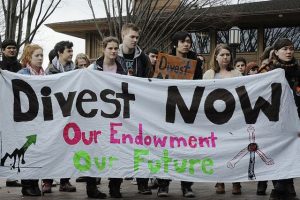One way that individuals can make a difference with regard to sustainability is through their portfolio choices in their retirement plans or other investments. There are now many opportunities to invest in companies, organizations, and funds with the objective to both generate a measurable, beneficial, social or environmental impact and provide a financial return for the investor. This type of investment is referred to as impact or socially responsible investing. It is also known as socially conscious, green, or ethical investing. This can include investment in assets such as stocks, exchange-traded funds, and mutual funds in which the underlying strategy seeks to consider both financial return, and environmental and social sustainability objectives.
the investor. This type of investment is referred to as impact or socially responsible investing. It is also known as socially conscious, green, or ethical investing. This can include investment in assets such as stocks, exchange-traded funds, and mutual funds in which the underlying strategy seeks to consider both financial return, and environmental and social sustainability objectives.
By directing retirement and other savings towards impact investments,  individuals that wish to promote the goals of sustainability are able to do so by directly supporting corporate practices that promote environmental stewardship, consumer protection, human rights, and diversity through impact investing. This can include environmental or green investments in companies that are either developing solutions to environmental problems such as alternative energy technology, or in companies that maintain the highest environmental standards. Social oriented investments may provide capital, credit, and training for economic development in low income and other underserved communities, or may invest in companies with a proven record of protecting and empowering workers.
individuals that wish to promote the goals of sustainability are able to do so by directly supporting corporate practices that promote environmental stewardship, consumer protection, human rights, and diversity through impact investing. This can include environmental or green investments in companies that are either developing solutions to environmental problems such as alternative energy technology, or in companies that maintain the highest environmental standards. Social oriented investments may provide capital, credit, and training for economic development in low income and other underserved communities, or may invest in companies with a proven record of protecting and empowering workers.
There are a variety of metrics that an individual investor can use to assess the positive impact of their investments. One major way is through the assessment of Environment, Social, and Governance (ESG) criteria for specific companies or funds. The environmental criteria measure a company’s performance in terms of environmental impact and stewardship including accounting for externalities. Social criteria examine how a company manages relationships with its employees, suppliers, customers and the communities where it operates. Governance deals with a company’s leadership, executive pay, audits and internal controls, and shareholder rights. Investors who want to purchase securities that have been screened for ESG criteria can do so through socially responsible mutual funds and exchange-traded funds. Most major investment firms provide independent ESG ratings. There has been some criticism of assessment criteria on ESG performance because reporting can be inconsistent. More detailed, uniform and independently assessed criteria are needed.
There are other metrics for assessing the sustainability of a corporation or fund. Corporate Knights (http://www.corporateknights.com/) and The Global Impact Investing Network (https://thegiin.org/) provide resources that assist individuals who wish to maximize their impact through personal investment. For those interested in making sure their investments are not put into high carbon emitting fossil fuel companies, The Carbon Underground 200TM identifies the top 100 public coal companies and the top 100 public oil and gas companies, ranks them by their potential carbon emissions content of their proven reserves[i].
Such impact investing is rapidly gaining in popularity. According to the US Forum for Sustainable and Responsible Investment, more than one out of every five dollars under professional management in the United States – or $8.75 trillion – is invested in assets that promote social or environmental causes. In the US, the overall number of mutual funds incorporating environmental and social benefits has increased 33% from 2015 to 2016[ii]. Globally, interest in impact investing is even more impressive – as much as 61% per year and well above $21.4 trillion. This outpaced the growth of total professionally managed assets[iii]. In many cases socially and environmentally investments are either equally or outperforming those not in this class.
The changing composition of the workforce is beginning to drive patterns of investment even further towards those with positive impact. By 2020 Millennials will comprise nearly half the working population, and thus have the potential to lead the effort to impact corporate values through investment. According to a study by Morgan Stanley in what is referred to as The Millennial Effect, members of this demographic are twice as likely to invest in companies or funds that target sustainability related outcomes compared to the total pool of investors with specific interest in investments that will directly address climate change or help reduce global poverty. Also, given their $2.5 trillion dollars of spending power they are acting to promoting corporate social and environmental responsibility by choosing brands that support these causes[iv].
Governments are also increasingly supporting impact investing. For example, in the UK, the government provides a 30% tax relief for social investments, which is anticipated to stimulate as much as GBP 500 million in additional investment over the next five years. The EU created a regulation to formally recognize funds that invest 70% of investor capital into European Social Entrepreneurship Funds, enabling these managers to market and fundraise more effectively among impact investors. In addition, government-controlled pension funds are often very large players in the investment field, and are being pressured by the by activists to adopt investment policies which encourage ethical corporate behavior, respect the rights of workers, consider environmental concerns, and avoid violations of human rights. One outstanding endorsement of such policies is the Government Pension Fund of Norway.
Another way that individuals can influence corporate behavior is through shareholder advocacy: proposing and representing resolutions that promote environmental, social, and governance change at annual stockholder meetings. As set forth by the US Securities and Exchange Commission, individuals have the opportunity to leverage their power of stock ownership to help further sustainability objectives. The organization As You Sow[v] promotes and supports shareholder advocacy in the areas of energy and water conservation, pollution prevention, waste reduction, environmentally and socially responsible sourcing, and community education and engagement.


